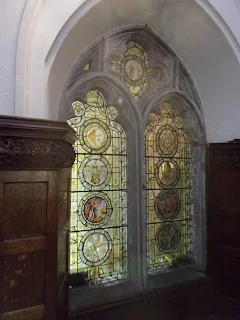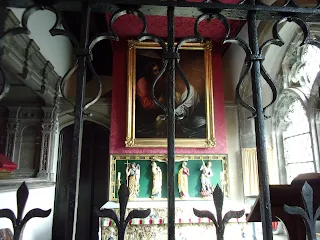Time and time again I used to walk past this place until I popped in during Open House Festival, which is an annual celebration of London's architecture, buildings and neighbourhoods. This was my third visit, was one of their additional bi-yearly open days and included a talk by one of the Friends of the Hospital Chapel.
This is the oldest building in Ilford- in fact it's the oldest in the London Borough of Redbridge- and sits on what was once a busy (for that day and age) road. Indeed, it is now an even busier thoroughfare- so much so that the chapel, which holds weekly Eucharist services on a Thursday as opposed to a Sunday (which leaves me somewhat confused) cannot expand into holding events such as blessings, vow renewals and funerals, as parking nearby is in limited supply. Maybe that's why using the chapel for Sunday services would be a problem? After all, you have to assume more would want to attend on the sabbath?
The Hospital Chapel of St Mary & St Thomas dates back to 1145, when King Stephen (r.1135-1154), William the Conqueror's grandson, was on the throne. It has never served as either a hospital or a chapel (which also leaves me somewhat confused, but I'll try to explain...)
Here is the entrance on Ilford Hill...
Inside the old part of the chapel, where we sat down and had our talk (a newer, Victorian addition is to the right of the building, through the arches).
The building served as a hospice for 13 aged and infirm men, although historians differ as to whether it was actually for lepers (the term leper was very loosely used, and appeared to represent various diseases) and was founded circa 1145 by Adelicia, Abbess of Barking. (I have come across variations in the spelling of her name: Adelidis and Adeliza.)
Further up the aisle, and in those days Barking Abbey was a wealthy and influential nunnery. The chapel was first dedicated to St Mary the Virgin. Later, Mary Becket became Abbess, and added the name of her brother- murdered Thomas Becket of Canterbury- in dedication to his memory.
The nave and chancel were built during the 14th century.

The chapel survived Henry VIII's break from Rome, probably due to it having its own endowments and constitution, and probably because of its additional function as a chapel-of-ease (a church building other than the parish church, built for those who might have trouble reaching the parish church conveniently.) It was taken over by the Crown, with Elizabeth I granting ownership to Member of Parliament Thomas Fanshawe, on condition that its charitable and religious work was maintained. It was confiscated during the Commonwealth although they regained ownership, relinquishing it to the Gascoyne family in about 1727.
The decoration here- including the rather effective twinkling starry sky- is down to the Victorians.
This 15th century altar stained glass window depicts the crucifixion in the centre, with the two Marys (Virgin and Magdalene) surrounding Jesus, and the other panels showing the chapel's namesakes: the Virgin Mary to the left, and Saint Thomas of Canterbury (Thomas Becket) to the right.

This is a Caen Stone Last Supper reredos (a large decoration or altarpiece often depicting religious images and placed behind an altar).
16th century Flemish heraldic stained glass remains in the chancel...

...These windows have been heavily restored...
The organ loft dates to the Victorian age, and you can see a bit of the carved India teak panelling which was added around this time.
Here you can see eight painted rood screen roof panels depicting saints. The open-ironwork, part-tubular decorative screen reaching to the ceiling was once used to convey gas jets for lighting.
I don't think such a thing would pass modern health and safety standards!
In their pamphlet this effigy is listed as Sir John Smythe, one time Master of the Hospital. But our guide contradicted this, saying that no one knows exactly who this life-size effigy depicts.
The Lady Chapel. This whole section, to the south of the chapel, was added during Victorian expansion/ restoration in 1889-90.
This carved wood reredos is by Sir John Ninian Comper, a Scot who was considered to be a great Gothic Revival architect.
The Virgin Mary.
The crypt has been sealed since 1959, when the carefully arranged remains of 22 skeletons and three detached skulls, showing evidence of violent death, were excavated. They were thought to be leprosy victims, but actually date to an age earlier than the chapel.
There are more than 60 lead-lined coffins, dating from 1821, and legend insists that there's also a secret tunnel down there- but apparently that's the stuff of make-believe, and nothing more.
The font, with behind it a stained glass memorial window by Edward Burne-Jones.
During recent conservation work this filled-in window was found in the original Norman wall. It's thought that it was infilled during the first 200 years after the chapel was built.
This rose window is attributed to Henry Holiday, part of the Pre-Raphaelite art movement.
The Gascoyne family married into the Bamber family, and a male child named Bamber Gascoyne existed in every generation right up until 2022, when the most recent holder died without issue.
I heard our guide refer to this as "the Bamber Gascoyne window" so perhaps it was one of this ilk who commissioned it...
To each side of the chapel sit almshouses, which were once quarters for "the poor brethren and the chaplains..."
...They have since been converted into modern, well-appointed flats.
From the outside they look charming.
Leaving the chapel, with Pioneer Point zooming up to the skies in the background. Who'd have thought such a place would sit between the overabundance of new high-rise developments and the proliferation of chicken shops?
In 1982 ownership was assumed by the Diocese of Chelmsford, and the Abbess Adelicia Trust now undertakes maintenance of the building.
The distinctive gate as we left.
The Friends of the Hospital Chapel was formed in 1992, to help fund restoration and preservation. Various low-key events- beside service and open days- take place, and there are some new and second-hand items, such as books, DVDs and cards, on sale around the chapel.
It's a nice place to sit in and absorb a bit of history whilst sipping on a cup of tea and nibbling a biscuit.
Sometimes London can dish up hidden gems, and this is one of them.
😊
TTFN
The Miss Elaineous
XXXXX
XXX
X
XXX
X






















No comments:
Post a Comment